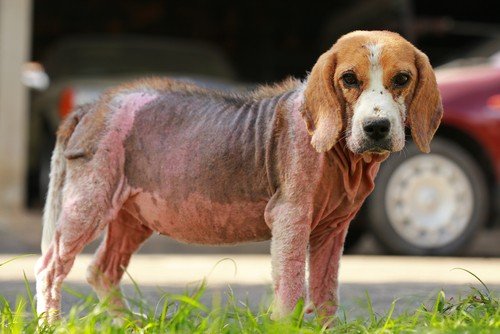Dogs are man’s best and most faithful friends. They tend to think and behave like us. Just as their owners, dogs, too, can get affected by health conditions. One of the common issues faced by dogs is dry skin. Moreover, like in human beings dog dry skin can occur due to a variety of reasons ranging from changes in weather to allergies to physiological diseases.
Understandably, dogs, too, can get extremely troubled and restless due to the problem of dry skin. Common signs of dry skin include red and flaky patches on the skin that are sensitive to touch. Know one thing – if your dog is repeatedly scratching itself against furniture or any rough surface, then it is a sign of dog dry skin issues.
Dog Dry Skin – Symptoms
If your dog is constantly scratching or restless, just observe its skin by parting its hair. If you see dry skin and loose hair on your dog, or you find that the skin is cracked, this is an obvious sign of dog dry skin.
Apart from various manifestations, dogs can exhibit one or many of the following prominent symptoms when experiencing dry skin.
- Dogs keep scratching, licking, and biting the affected area.
- They keep rubbing the affected part against walls, furniture, or any surface.
- You can find the appearance of scaly patches on the skin.
- There is skin redness or discoloration in the affected areas.
- Not only that, but you can also sometimes observe bald patches on the affected areas.
- Lumps and lesions appear on the dog’s skin.
Dog Dry Skin – Causes
The dry skin problem in dogs mainly indicates an absence of sufficient levels of moisture. When the problem is such virulent, don’t you think it is a great idea to dwell deep into it? While the reasons can be as varied as weather changes to changes in food, care must be taken to protect the pet from such variations. Also, allergies caused by factors such as mold, etc. trigger dry skin in dogs. Besides, various diseases, ticks, and molds can also cause dry skin in dogs. Dog owners should be able to identify the cause of the dry skin condition on time, making it easy to give the appropriate treatment.
Here is a list of some of the common causes of dry skin in dogs:
Weather conditions
A sudden change in weather, dry or cold weather or warm climate can cause dry skin in dogs.
Poor Nutrition
If a dog is not getting enough nutrition in its diet, the skin can lose its moisture and sheen, resulting in dry skin conditions and itching.
Allergies
Dogs can get allergies just like humans do, and these allergies may lead to dry skin conditions. Some of the common types of allergies in dogs are:
- Food allergies
- Mold allergies
- Environmental allergies ex: Smoke
- Seasonal allergies: ex: Flea saliva, pollen, dust, grain, animal dander, etc.
- Allergies to certain medications.
- Not only medications, shampoos, and soaps too can trigger allergies.
Infections
Various infections can be responsible for causing dog dry skin. The common kinds of skin infections that can cause dry skin in dogs include:
- Bacterial infections.
- Yeast infections.
- Fungal infections.
- Parasitic infections.
Fleas
Dog owners consider fleas the biggest threat to their dogs. Consequently, they wish to fight the Flea allergy dermatitis or allergy caused due to flea bites vigorously. Symptoms include severe itching or pruritis, behavior problems, hair loss, and scabs. And you know where this occurs? Usually, this kind of allergy occurs on the back half of the dog, though sometimes the whole body can be affected. Other symptoms of flea allergies include severe licking, scratching, and the formation of hotspots.
Physiological Disorders
In dogs, dry skin may sometimes indicate bigger causes like physiological diseases and conditions. Hypothyroidism and Cushing’s disease are two such conditions responsible for causing dry skin in dogs.
Just take a look at the table below to get a bird’s eye view of the problem of dry skin in dogs and the measures to be taken to deal with them.
Dog Dry Skin – Treatment
My dog has dry flaky skin. What do I do?
This is a common question that dog owners have. There are many causes for dog dry skin. The treatment will vary depending on the cause. While dry skin due to changes in weather can be treated with moisturizers, certain other allergies may require a trip to the veterinary doctor.
Weather
Changes in weather are one of the basic and common causes of dog dry skin. You can make some changes in your as well your dog’s routine to ensure that your dog can recover and effectively from dry skin issues. Dog dry itchy skin treatment needs constant moisturization and hydration.
Treatment: Since the dry weather sucks away the moisture in dogs, causing a lot of dry skin problems, the right grooming routine can help fight dry skin in dogs in the winter season.
Brushing your dog daily
In case your dog is suffering from dry skin, as a first step, you should brush your dog regularly with a good comb. Brushing not only removes dry flaky skin and loose hair that has settled on your dog’s body but also improves the stimulation and distribution of the body’s natural oils. Overall, this will create a natural protective barrier for your dog’s skin against dryness.
You can buy brushes like Glendan Dog Brush and Pogi’s Grooming Wipes for your dog.
Bathing your dog less frequently
You need to change your dog’s bath routine during winters since bathing them regularly in this season can deplete the skin of its natural moisture and oils. Use lukewarm water when bathing your dogs. You can use good quality moisturizers, shampoos, and conditioners, which will help keep your dog’s skin moist. You can buy Warren London Hydrating Butter for your four-legged friend.
Use humidifiers
Running humidifiers will aid in adding some moisture to the home environment and help reduce dryness in dogs to a certain extent.
Hydrate them
Give your dogs plenty of water to drink. This is an essential step in ensuring constant hydration and avoiding dry skin in dogs.

Allergies
Allergens, the second most common cause of dry skin in dogs, can be of various types. Dogs can get seasonal allergies due to allergens such as pollen, dust, mold, mold spores, and fleas.
When dogs suffer from seasonal allergies, they can exhibit one or more of the following symptoms.
- Dog dry flaky skin and hair loss
- Itching and scratching
- Irritation and watering of eyes
- Repeated sneezing.
- Swollen skin
- Diarrhea and vomitings in rare cases.
The following treatment steps can help a dog in dealing with the discomfort caused by seasonal allergies:
Change their walking routine
Generally, the concentration of pollen is high during early mornings and late afternoons. This means that dogs should not be exposed to walks at these times. Dogs should be taken out for walks when the pollen content is considerably low. For example, they can go out for their daily walks during the early afternoons or at night when pollen concentration is low.
Maintain Hygiene
You should make sure that your dog stays clean and allergen-free at all times. To ensure this, firstly clean your dogs, especially their feet with a wet cloth, allergy-friendly wet wipes, or with diluted apple cider vinegar solution (mix one part apple cider vinegar with two parts of clean water). Make sure to concentrate on areas prone to allergies due to exposure and affected parts. This ensures that allergens do not enter the home atmosphere.
Secondly, make vacuuming a regular chore. You need to vacuum your entire home, concentrating on nooks and crannies, where dust, pollen, and mites can accumulate. Do not allow your dog to enter moisture and mold-prone areas such as laundry rooms and basements.
Wash all beds, bed sheets, and pillows regularly with hot water and soap. Keep all surfaces clean all times.
Keep the air inside the home clean
Change the air filters inside the home regularly during allergy seasons. Run the air-conditioners and dehumidifiers at frequent intervals. Apart from vacuuming the house, make sure you also clean the curtains, carpets, and rugs regularly. These steps will help keep pollen and mold at bay.
Give your dogs regular baths
Consider giving your dogs regular baths during allergy seasons to prevent dog dry skin. You can use mild hypo-allergic soaps with natural soothing ingredients to bath them.
Add Supplements
Make sure that your dog is eating healthy food and drinking enough water. You can add probiotics to their diet to improve their gut health and overall health. You can also give your natural dog supplements that will help improve their overall skin health – like fish oils, omega-3, and omega 6 supplements, etc.
Pouri sells Fish oil Omega 3 supplements for your dogs.
Visit a Vet
If your dog still doesn’t seem to get any relief from dry skin, you can also take your dog to the vet for further examination and medications.
Infections
Dog dry skin can also occur due to various types of infections. A visit to the vet is warranted when such types of conditions occur. Let us have a look at the various infections that can cause dog dry skin.
Yeast Infections
Dogs can be treated from these infections by the use of oral drugs, medicated creams, or medicated baths. A vet will suggest the best medications depending on the severity of the infection.
Bacterial Infections
Folliculitis and Impetigo are two bacterial infections that can commonly be seen in dogs. Folliculitis is generally treated with antibiotic medications and creams, while Impetigo may be reduced with the application of topical ointments. Again the vet is the best person to diagnose and treat these infections.
Fungal Infections
Ringworms are a common type of fungal infection seen in dogs. The name ringworm is given due to the ring-shaped patches formed on the dog’s body as a result of the infection. Many medicated ointments are available to treat this condition in dogs.
Parasitic Infections
Parasites by the name mites cause a skin condition called Mange in dogs. Common types of Mange include Sarcoptic Mange (canine scabies) and Demodectic Mange.
Fleas
Flea infestation is a menace to dog-owners. If you own a dog and suspect flea presence, make sure you get your home and yard cleaned for fleas regularly. Your vet can prescribe oral medications and topical solutions for your dog. You can use flea combs like GNAWRISHING Flea Comb as an effective treatment.
As a dog-owner, you need to identify and take measures for your dog’s skin-related issues. This will ensure that your dog stays comfortable through the healing process.
Dog dry skin – Home Remedies
Vitamin E oil
Vitamin E oil is an effective dog dry skin remedy. Massaging your dog with vitamin E oil not only treats the dry skin but also provides protection against UV rays and also gives a healthy coat to your dog.
Oatmeal
This is another effective home remedy to soothe dry and itchy skin. It calms down itchy skin and hotspots and provides overall relief to your dogs.
You can simply grid oatmeal to a fine powder, mix it with water to form a paste, and then apply it to the affected areas. Alternatively, you can add oatmeal to your dog’s bath.
Lillian Ruff is a brand that makes Oatmeal dog shampoo.
Coconut Oil
You can apply coconut oil to your dog’s affected areas. Coconut oil can calm down itchy skin and also provides moisturization.
Tea tree Oil
This oil is very effective for flea prevention. You can bathe your dog with water that contains a mixture of oatmeal and tea tree oil or neam oil. This bath can be repeated weekly for effective treatment against fleas.
Dry skin in dogs can occur due to several reasons, but most of these are simple and can be effectively treated at home. Some conditions may require a vet’s intervention. Early detection and timely treatment are the keys to a happy and comfortable dog.






